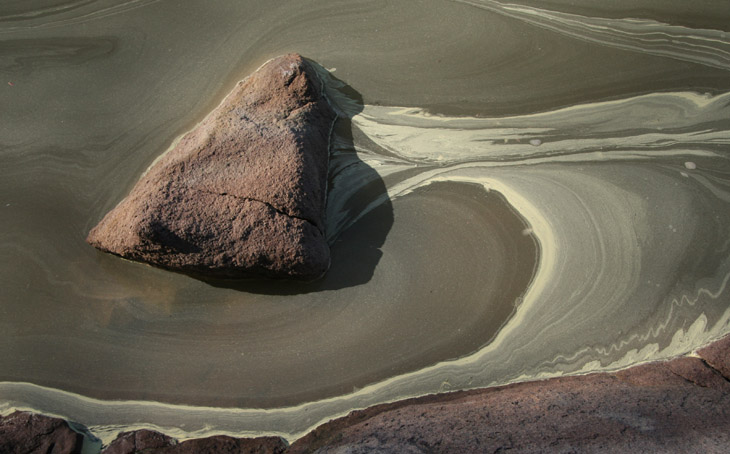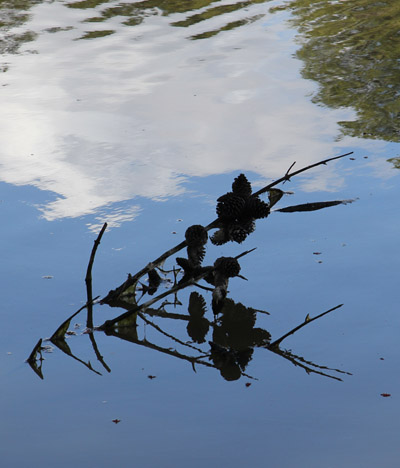
I pretty much knew this was going to be the month-end abstract as soon as I took it – with the caveat, of course, that I might find something better afterward, but here it is, so you have a tiny insight into my photography outings. I don’t suppose this is too hard to figure out, but it’s pine season here and the fucking pollen gets all over everything, and it floats. So lakes and puddles and even stream edges get decorated with the stuff for a few weeks, and in the case here, it gives a good indication of how water is shifting even when no currents or even breezes are evident.
More abstract, perhaps, is the scale, since there’s nothing to provide a reference. If I’d brought a toy boat with me I could have had a lot of fun with you, but somehow I forgot to pack one in the bag (I know, I know, after all my admonishments to be prepared.) Suffice to say this is at my feet at 26mm focal length, and my foot might have just spanned the gap between the shore and the rock.
 As I was preparing this post, I was trying to remember what I’d posted for February, and eventually came to the conclusion that I had never done a month-end abstract for February – don’t know how that one got past. Though I have some idea, because I shot almost nothing in February, and so as I was attempting to rectify my oversight, I was finding very little to use that was taken within the month. I found a couple that weren’t bad in my folders, but they were taken in either January or March, and I was determined, for no particular reason, to stay within February. So here we are, continuing a theme of sorts, since this is a pine branch replete with cones, partially submerged in the pond. It’s not a pretty picture, it’s just a little stark and confusing, but the sky color came out well.
As I was preparing this post, I was trying to remember what I’d posted for February, and eventually came to the conclusion that I had never done a month-end abstract for February – don’t know how that one got past. Though I have some idea, because I shot almost nothing in February, and so as I was attempting to rectify my oversight, I was finding very little to use that was taken within the month. I found a couple that weren’t bad in my folders, but they were taken in either January or March, and I was determined, for no particular reason, to stay within February. So here we are, continuing a theme of sorts, since this is a pine branch replete with cones, partially submerged in the pond. It’s not a pretty picture, it’s just a little stark and confusing, but the sky color came out well.
A couple of small notes about the silhouette and exposure. Had I wanted to bring out the detail of the branches instead of making them this dark, I could always have rejected what the camera considered a good exposure and brightened it up with exposure compensation – but that would have bleached out the sky, weakening the colors which are the strong point of the image; the cloud would have lost all texture on its own. So the other option is fill-flash, firing off the flash even though the exposure was fine. It would have had absolutely no effect on the water reflections and the color therein, but it would have illuminated this side of the branches and brought out their detail. In such cases, it can help to have a camera and flash unit that can do flash-exposure compensation. Left to its own devices (heh!) a camera using any variation of TTL flash exposure will try to match flash power output to the ambient light, to make it look “natural,” but in this case that exposure could be up for grabs, since the meter is going to read the bright sky overall, and might not even register the branches. It might not fire at all, “believing” that no flash is needed, or it might pour out a lot of power to try and spark a reaction from the exposure meter and end up over-illuminating them. With flash-exposure compensation, you can tell the camera to put out more or less light than it “thinks” it needs. Without such an option, you can usually force the flash to fire anyway, and reduce the light as needed by partially covering the flash head with your fingers, or tilting the head up away from a direct line to provide only partial lighting. It might take a few attempts to get the right result, but in some cases (something more interesting than these branches, at least,) it can be worth the effort.
One more thing: don’t trust the LCD on the back of the camera to show you how well the exposure worked. They’re notoriously unreliable for judging exposure, able to make the image seem brighter or darker than it really is, partially from the brightness settings, partially from ambient light, and mostly because their initial gamma setting is both unknown and unalterable (at least in every case I’ve seen.) So, bracket, even when it looks good in the LCD.



















































